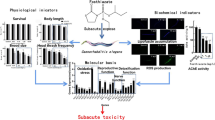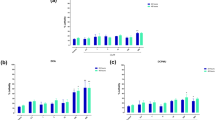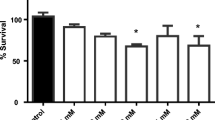Abstract
Fluopimomide is a novel pesticide intensively used in agricultural pest control; however, its excessive use may have toxicological effects on non-target organisms. In this study, Caenorhabditis elegans was used to evaluate the toxic effects of fluopimomide and its possible mechanisms. The effects of fluopimomide on the growth, pharyngeal pumping, and antioxidant systems of C. elegans were determined. Furthermore, the gene expression levels associated with mitochondria in the nematodes were also investigated. Results indicated that fluopimomide at 0.2, 1.0, and 5.0 mg/L notably (p < 0.001) decreased body length, pharyngeal pumping, and body bends in the nematodes compared to the untreated control. Additionally, fluopimomide at 0.2, 1.0, and 5.0 mg/L notably (p < 0.05) increased the content of malondialdehyde by 3.30-, 21.24-, and 33.57-fold, respectively, while fluopimomide at 1.0 and 5.0 mg/L significantly (p < 0.001) increased the levels of reactive oxygen species (ROS) by 49.14% and 77.06% compared to the untreated control. In contrast, fluopimomide at 1.0 and 5.0 mg/L notably reduced the activities of target enzyme succinate dehydrogenase and at 5.0 mg/L reduced the activities of antioxidant enzyme superoxide dismutase. Further evidence revealed that fluopimomide at 1.0 and 5.0 mg/L significantly inhibited oxygen consumption and at 0.2, 1.0, and 5.0 mg/L significantly inhibited ATP level in comparison to the untreated control. The expression of genes related to the mitochondrial electron transport chain mev-1 and isp-1 was significantly downregulated. ROS levels in the mev-1 and isp-1 mutants after fluopimomide treatments did not change significantly compared with the untreated mutants, suggesting that mev-1 and isp-1 may play critical roles in the toxicity induced by fluopimomide. Overall, the results demonstrate that oxidative stress and mitochondrial damage may be involved in toxicity of fluopimomide in C. elegans.






Similar content being viewed by others
Data availability
The datasets used and/or analyzed during the current study are available from authors on a reasonable request.
References
Aguilar-López JL, Laboy R, Jaimes-Miranda F, Garay E, Funes S (2016) Slm35 links mitochondrial stress response and longevity through TOR signaling pathway. Aging 8:3255–3271. https://doi.org/10.18632/aging.101093
Avenot HF, Michailides TJ (2010) Progress in understanding molecular mechanisms and evolution of resistance to succinate dehydrogenase inhibiting (SDHI) fungicides in phytopathogenic fungi. Crop Prot 29:643–651. https://doi.org/10.1016/j.cropro.2010.02.019
Bailey DC, Todt CE, Burchfield SL, Pressley AS, Denney RD, Snapp IB, Negga R, Traynor WL, Fitsanakis VA (2018) Chronic exposure to a glyphosate-containing pesticide leads to mitochondrial dysfunction and increased reactive oxygen species production in Caenorhabditis elegans. Environ Toxicol Pharmacol 57:46–52. https://doi.org/10.1016/j.etap.2017.11.005
Bian T, Zhu X, Guo J, Zhuang Z, Cai Z, Zhao X (2018) Toxic effect of the novel chiral insecticide IPP and its biodegradation intermediate in nematode Caenorhabditis elegans. Ecotox Environ Safe 164:604–610. https://doi.org/10.1016/j.ecoenv.2018.08.059
Bora S, Vardhan GSH, Deka N, Khataniar L, Gogoi D, Baruah A (2021) Paraquat exposure over generation affects lifespan and reproduction through mitochondrial disruption in C. elegans. Toxicology 447:152632. https://doi.org/10.1016/j.tox.2020.152632
Brenner S (1974) The genetics of Caenorhabditis elegans. Genetics 77:71–94. https://doi.org/10.1093/genetics/77.1.71
Calahorro F, Holden-Dye L, O'Connor V (2021) Impact of drug solvents on C. elegans pharyngeal pumping. Toxicol Rep 8:1240–1247. https://doi.org/10.1016/j.toxrep.2021.06.007
Collins JJ, Huang C, Hughes S, Kornfeld K (2008) The measurement and analysis of age-related changes in Caenorhabditis elegans. Wormbook 1:21. https://doi.org/10.1895/wormbook.1.137.1
Dai S, Zhang Y, Miao Y, Liu R, Pu Y, Yin L (2019) Intergenerational reproductive toxicity of chlordecone in male Caenorhabditis elegans. Environ Sci Pollut R 26:11279–11287. https://doi.org/10.1007/s11356-019-04519-1
Donkin SG, Dusenbery DB (1993) A soil toxicity test using the nematode Caenorhabditis elegans and an effective method of recovery. Arch Environ Con Tox 25:145–151. https://doi.org/10.1007/BF00212125
Feng J, Bussière F, Hekimi S (2001) Mitochondrial electron transport is a key determinant of life span in Caenorhabditis elegans. Dev Cell 1:633–644. https://doi.org/10.1016/S1534-5807(01)00071-5
Gruber J, Chen CB, Fong S, Ng LF, Teo E, Halliwell B (2015) Caenorhabditis elegans: What we can and cannot learn from aging worms. Antioxid Redox Sign 23:256–279. https://doi.org/10.1089/ars.2014.6210
Guzy RD, Sharma B, Bell E, Chandel NS, Schumacker PT (2008) Loss of the SdhB, but not the SdhA, subunit of complex II triggers reactive oxygen species-dependent hypoxia-inducible factor activation and tumorigenesis. Mol Cell Biol 28:718–731. https://doi.org/10.1128/MCB.01338-07
Hunt PR (2017) The C. elegans model in toxicity testing. J Appl Toxicol 37:50–59. https://doi.org/10.1093/toxsci/kfn121
Ishii N (2000) Oxidative stress and aging in Caenorhabditis elegans. Free Radic Res 33:857–864. https://doi.org/10.1080/10715760000301371
Islam MT (2017) Oxidative stress and mitochondrial dysfunction-linked neurodegenerative disorders. Neurol Res 39:73–82. https://doi.org/10.1080/01616412.2016.1251711
Jardim-Messeder D, Caverzan A, Rauber R, de Souza FE, Margis-Pinheiro M, Galina A (2015) Succinate dehydrogenase (mitochondrial complex II) is a source of reactive oxygen species in plants and regulates development and stress responses. New Phytol 208:776–789. https://doi.org/10.1111/nph.13515
Ji X, Li J, Meng Z, Li N, Dong B, Zhang S, Qiao K (2020) Fluopimomide effectively controls Meloidogyne incognita and shows a growth promotion effect in cucumber. J Pest Sci 93:1421–1430. https://doi.org/10.1007/s10340-020-01247-1
Ji P, Li H, Jin Y, Peng Y, Zhao L, Wang X (2022) C. elegans as an in vivo model system for the phenotypic drug discovery for treating paraquat poisoning. PeerJ 10:e12866. https://doi.org/10.7717/peerj.12866
Jones JG, Kleczewski NM, Desaeger J, Meyer SL, Johnson GC (2017) Evaluation of nematicides for southern root-knot nematode management in lima bean. Crop Prot 96:151–157. https://doi.org/10.1016/j.cropro.2017.02.015
Kamaladevi A, Ganguli A, Balamurugan K (2016) Lactobacillus casei stimulates phase-II detoxification system and rescues malathion-induced physiological impairments in Caenorhabditis elegans. Comp Biochem Phys C 179:19–28. https://doi.org/10.1016/j.cbpc.2015.08.004
Kamireddy K, Chinnu S, Priyanka PS, Rajini PS, Giridhar P (2018) Neuroprotective effect of Decalepis hamiltonii aqueous root extract and purified 2-hydroxy-4-methoxy benzaldehyde on 6-OHDA induced neurotoxicity in Caenorhabditis elegans. Biomed Pharmacother 105:997–1005. https://doi.org/10.1016/j.biopha.2018.06.002
Kuhn E, Jacques M, Teixeira D, Meyer S, Gralha T, Roehrs R, Camargo S, Schwerdtle T, Bornhorst J, Ávila D (2021) Ecotoxicological assessment of Uruguay River and affluents pre-and post-pesticides’ application using Caenorhabditis elegans for biomonitoring. Environ Sci Pollut R 28:21730–21741. https://doi.org/10.1007/s11356-020-11986-4
Lee H, Ko E, Shin S, Choi M, Kim KT (2021) Differential mitochondrial dysregulation by exposure to individual organochlorine pesticides (OCPs) and their mixture in zebrafish embryos. Environ Pollut 277:115904. https://doi.org/10.1016/j.envpol.2020.115904
Leung M, Williams P, Benedetto A, Au C, Helmcke K, Aschner M, Meyer J (2008) Caenorhabditis elegans: an emerging model in biomedical and environmental toxicology. Toxicol Sci 106:5–28. https://doi.org/10.1093/toxsci/kfn121
Li CJ, Yuan SF, Jiang F, Xie YF, Guo YH, Yu H, Cheng YL, Qian H, Yao WR (2020b) Degradation of fluopyram in water under ozone enhanced microbubbles: kinetics, degradation products, reaction mechanism, and toxicity evaluation. Chemosphere 258:127216. https://doi.org/10.1016/j.chemosphere.2020.127216
Li J, Meng Z, Li N, Dong B, Ji X, Zhang S, Qiao K (2020a) Evaluating a new non-fumigant nematicide fluopimomide for management of southern root-knot nematodes in tomato. Crop Prot 129:105040. https://doi.org/10.1016/j.cropro.2019.105040
Li X, Yang Q, Wang L, Song C, Chen L, Zhang J, Liang Y (2022) Using Caenorhabditis elegans to assess the ecological health risks of heavy metals in soil and sediments around Dabaoshan Mine, China. Environ Sci Pollut R 29:16332–16345. https://doi.org/10.1007/s11356-021-16807-w
Liu Y, Zhang WP, Wang Y, Liu HM, Zhang SA, Ji XX, Qiao K (2021) Oxidative stress, intestinal damage, and cell apoptosis: toxicity induced by fluopyram in Caenorhabditis elegans. Chemosphere 286:131830. https://doi.org/10.1016/J.chemosphere.2021.131830
Liu S, Wu Q, Zhong Y, He Z, Wang Z, Li R, Wang M (2022) Fosthiazate exposure induces oxidative stress, nerve damage, and reproductive disorders in nontarget nematodes. Environ Sci Pollut R 30:1–10. https://doi.org/10.1007/s11356-022-23010-y
López-García G, Cilla A, Barberá R, Genovés S, Martorell P, Alegría A (2020) Effect of plant sterol and galactooligosaccharides enriched beverages on oxidative stress and longevity in Caenorhabditis elegans. J Funct Foods 65:103747
Maglioni S, Arsalan N, Hamacher A, Afshar S, Schiavi A, Beller M, Ventura N (2022) High-content C. elegans screen identifies natural compounds impacting mitochondria-lipid homeostasis and promoting healthspan. Cells 11(1):100
Mates JM, Segura JA, Alonso FJ, Marquez J (2008) Intracellular redox status and oxidative stress: implications for cell proliferation, apoptosis, and carcinogenesis. Arch Toxicol 82:273–299. https://doi.org/10.1007/s00204-008-0304-z
Meyer JN, Leuthner TC, Luz AL (2017) Mitochondrial fusion, fission, and mitochondrial toxicity. Toxicology 391:42–53. https://doi.org/10.1016/j.tox.2017.07.019
Nidheesh T, Salim C, Rajini PS, Suresh PV (2016) Antioxidant and neuroprotective potential of chitooligomers in Caenorhabditis elegans exposed to Monocrotophos. Carbohyd Polym 135:138–144. https://doi.org/10.1016/j.carbpol.2015.08.055
Quinlan C, Orr A, Perevoshchikova I, Treberg J, Ackrell B, Brand M (2012) Mitochondrial complex II can generate reactive oxygen species at highrates in both the forward and reverse reactions. J Biol Chem 287:27255–27264. https://doi.org/10.1074/jbc.M112.374629
Ruan Q, Ju J, Li Y (2009) Evaluation of pesticide toxicities with differing mechanisms using Caenorhabditis elegans. J Toxicol Env Heal A 72:746–751. https://doi.org/10.1080/15287390902841532
Soares A, Rodrigues L, Salgueiro W, Dal Forno A, Rodrigues C, Sacramento M, Franco J, Alves D, Oliveira R, Pinton S, Ávila D (2019) Organoselenotriazoles attenuate oxidative damage induced by mitochondrial dysfunction in mev-1 Caenorhabditis elegans mutants. J Trace Elem Med Bio 53:34–40. https://doi.org/10.1016/j.jtemb.2019.01.017
Soares GC, Müller L, Josende ME, Ventura-Lima J (2023) Biochemical and physiological effects of multigenerational exposure to spheric polystyrene microplastics in Caenorhabditis elegans. Environ Sci Pollut R 30:69307–69320. https://doi.org/10.1007/s11356-023-27162-3
Tejeda-Benitez L, Olivero-Verbel J (2016) Caenorhabditis elegans, a biological model for research in toxicology. Rev Environ Contam T 237:1–35. https://doi.org/10.1007/978-3-319-23573-8_1
Tinwell H, Rouquié D, Schorsch F, Geter D, Bars R (2014) Liver tumor formation in female rat induced by fluopyram is mediated by CAR/PXR nuclear receptor activation. Regul Toxicol Pharm 70:648–658. https://doi.org/10.1016/j.yrtph.2014.09.011
Tsalik E, Hobert O (2003) Functional mapping of neurons that control locomotory behavior in Caenorhabditis elegans. J Neurobiol 56:178–197. https://doi.org/10.1002/neu.10245
Wang DY (2019) Molecular toxicology in Caenorhabditis elegans. Springer Nature Singapore Pte Ltd
Xiong H, Pears C, Woollard A (2017) An enhanced C. elegans based platform for toxicity assessment. Sci Rep 7:9839. https://doi.org/10.1038/s41598-017-10454-3
Yan C, Wu X, Cao X, Li M, Zhou L, Xiu G, Zeng J (2021) In vitro and in vitro toxicity study of diesel exhaust particles using BEAS-2B cell line and the nematode Caenorhabditis elegans as biological models. Environ Sci Pollut R 28:60704–60716. https://doi.org/10.1007/s11356-021-14908-0
Yin J, Jian Z, Zhu G, Yu X, Pu Y, Yin L, Wang D, Bu Y, Liu R (2021) Male reproductive toxicity involved in spermatogenesis induced by perfluorooctane sulfonate and perfluorooctanoic acid in Caenorhabditis elegans. Environ Sci Pollut R 28:1443–1453. https://doi.org/10.1007/s11356-020-10530-8
Yu C, Wei C, Liao VH (2014) Curcumin-mediated oxidative stress resistance in Caenorhabditis elegans is modulated by age-1, akt-1, pdk-1, osr-1, unc-43, sek-1, skn-1, sir-2.1, and mev-1. Free Radic Res 48:371–379. https://doi.org/10.3109/10715762.2013.872779
Zeng R, Yu X, Tan X, Ye S, Ding Z (2017) Deltamethrin affects the expression of voltage-gated calcium channel α1 subunits and the locomotion, egg-laying, foraging behavior of Caenorhabditis elegans. Pestic Biochem Phys 138:84–90. https://doi.org/10.1016/j.pestbp.2017.03.005
Zhang R, Wang H, Xu H, Wang J, Wang K (2014) Uptake and transportation behavior of a new fungicidal agent LH-2010A in cucumber plants. J Pestic Sci 39:43–47. https://doi.org/10.1584/jpestics.D13-017
Zhang WP, Liu HM, Fu GH, Li YJ, Ji XX, Zhang SA, Wei M, Qiao K (2022) Exposure to fluopimomide at sublethal doses causes oxidative stress in Caenorhabditis elegans regulated by insulin/insulin-like growth factor 1-like signaling pathway. Environ Toxicol 10:2529–2539. https://doi.org/10.1002/tox.23616
Akash S, Sivaprakash B, Rajamohan N, Pandiyan CM, Vo DVN (2022) Pesticide pollutants in the environment-a critical review on remediation techniques, mechanism and toxicological impact. Chemosphere 134754. https://doi.org/10.1016/j.chemosphere.2022.134754
Olsen A, Gill MS (2017) Ageing: Lessons from C. elegans. https://doi.org/10.1007/978-3-319-44703-2
Tang J, Qin J, Kuerban G, Li J, Zhou Q, Zhang H, Sun R, Yin L, Pu Y, Zhang J (2023) Effects of tri-n-butyl phosphate (TnBP) on neurobehavior of Caenorhabditis elegans. Environ Sci Pollut R. https://doi.org/10.1007/s11356-023-28015-9
Funding
This work was supported by Shandong Provincial Natural Science Foundation (ZR2021MC065), Shandong Innovation Capability Enhancement Project for Technological Small and Medium sized Enterprises (2023TSGC0613), Shandong Province Modern Agricultural Technology System Peanut Innovation Team, China (SDAIT-04-08), and National Natural Science Foundation of China (31601661).
Author information
Authors and Affiliations
Contributions
KQ and XJ conceived and designed the research. HL, GF, LB, and WL conducted the experiments and analyzed data. All authors contributed to discussion of the results. KQ and SZ supervised the research, and reviewed and revised the manuscript. KQ wrote the paper. All authors read this manuscript and approved its submission.
Corresponding author
Ethics declarations
Ethics approval and consent to participate
This article does not contain any studies with human participants or animals performed by any of the authors. Informed consent was obtained from all individual participants included in the study.
Consent for publication
The authors agree that the article will be published by the journal after acceptance.
Competing interests
The authors declare no competing interests.
Additional information
Responsible Editor: Chris Lowe
Publisher’s note
Springer Nature remains neutral with regard to jurisdictional claims in published maps and institutional affiliations.
Supplementary information
ESM 1
(DOCX 317 kb)
Rights and permissions
Springer Nature or its licensor (e.g. a society or other partner) holds exclusive rights to this article under a publishing agreement with the author(s) or other rightsholder(s); author self-archiving of the accepted manuscript version of this article is solely governed by the terms of such publishing agreement and applicable law.
About this article
Cite this article
Liu, H., Fu, G., Li, W. et al. Oxidative stress and mitochondrial damage induced by a novel pesticide fluopimomide in Caenorhabditis elegans. Environ Sci Pollut Res 30, 91794–91802 (2023). https://doi.org/10.1007/s11356-023-28893-z
Received:
Accepted:
Published:
Issue Date:
DOI: https://doi.org/10.1007/s11356-023-28893-z




